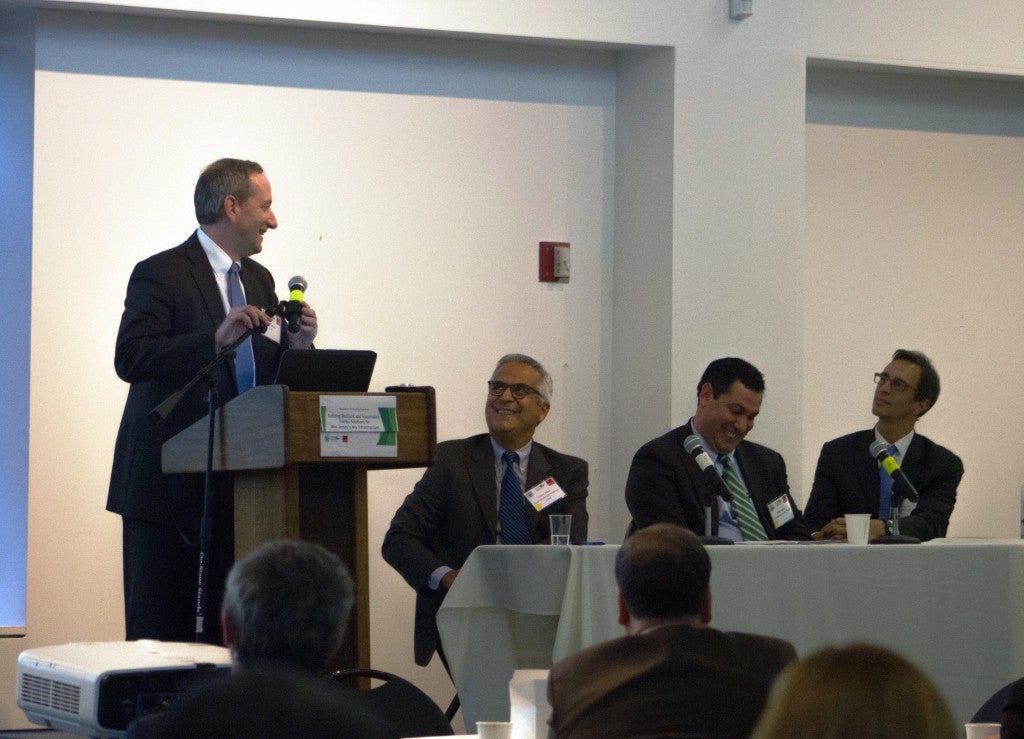By: Audrey Hornick-Becker

From left to right: Bruce Schlein, Director, Alternative Energy Finance, Citi; Vic Rojas, EDF senior manager, financial policy; Bryan Garcia, President, Connecticut Green Bank; Alfred Griffin, President, NY Green Bank. Source: Maria Jiang.
Last week, EDF co-hosted a successful first-of-its-kind Resilience Finance Symposium in New Jersey, attended by about 120 participants from a wide spectrum of public and private entities in the state, region, and country.
Held on November 12 with Governor Christie’s Administration and the New Jersey Institute of Technology’s College of Architecture + Design, the all-day Resilience Finance Symposium: Building Resilient and Sustainable Energy Solutions for New Jersey’s Key Infrastructure featured a series of panels on solutions that help keep the lights and heat on during critical times, like microgrids and energy storage, as well as innovative ways of financing resilient energy systems.
A main topic of discussion was the impressive progress New Jersey has made toward making the state’s energy infrastructure more resilient in the two years since Superstorm Sandy caused a massive weeks-long power outage. Panelists pointed to Sandy success stories – those instances when power stayed on even when the grid went down – and discussed the need to make these kinds of successes the norm rather than the exception.
One shining example was Princeton University’s microgrid, which was able to ‘island’ itself from the main grid and provide much-needed power to 12,000 people. Princeton University Energy Plant Manager, Ted Borer, was on hand to explain how the microgrid, fueled by a gas-turbine generator and solar power, was an effective low-carbon solution that can be replicated across the state.
Eric Daleo, New Jersey Transit’s Director, Superstorm Sandy Recovery and Resilience Program, spoke about the newly-funded NJ Transitgrid, which was awarded $410 million in federal funds to develop a microgrid that will service the state’s transportation system. He noted that a microgrid, which can function independently from the main grid during an emergency, can allow service crews to carry out critical recovery efforts.
Energy efficiency was also discussed as a resiliency solution, with Elizabeth Ackerman, Acting Director of Economic Development and Energy Policy, New Jersey Board of Public Utilities, reminding us that including energy efficiency in resiliency projects is critical. One of the biggest barriers to energy efficiency projects is the lack of a standard method of measuring, evaluating, and verifying savings, which deters more investors from participating.
Sean Neill, a leading energy efficiency consultant, discussed how the Investor Confidence Project – a project he helped found with the Environmental Defense Fund – aims to address these barriers by standardizing how energy efficiency projects are developed and energy savings estimates are calculated. Ms. Ackerman announced that New Jersey is exploring the adoption of the Investor Confident Project protocols for use in the state’s commercial energy efficiency programs.
While panels in the morning focused on why resiliency solutions are important, speakers in the afternoon turned to the discussion of how to finance them. Mitch Carpen, the newly appointed Executive Director of the New Jersey Energy Resilience Bank, discussed the bank’s first product, which will fund critical facilities such as water and wastewater treatment plants.
At the final panel on the region’s green banks – moderated by EDF’s own, Vic A. Rojas, Senior Manager, Financial Policy – Bryan Garcia, President and CEO of the Connecticut Green Bank, spoke alongside Alfred Griffin, President of the NY Green Bank, about the need for green banks to help build a self-sustaining market in clean energy finance by leveraging limited public funds to catalyze private investment. Bruce Schlein, Director, Alternative Energy Finance at Citi, echoed this sentiment, saying state-sponsored entities and well-recognized non-profits should pave the way to more clean energy finance deals in the private sector with technical assistance and a vote of confidence.
Agreeing that we already have the technology to create a clean and resilient energy infrastructure in New Jersey, participants called for policies encouraging resilient solutions and new ways to finance them. With the expanded use of microgrids and other clean energy solutions, a focus on energy efficiency, and the newly established Energy Resilience Bank, New Jersey is certainly making a tremendous effort to make sure the state is prepared for future extreme storms. EDF would like to thank all speakers and attendees for an engaging and fruitful Resilience Finance Symposium.









